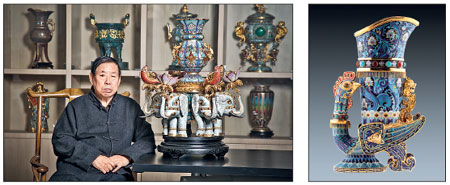Cloisonne art pieces retain their traditional appeal
Updated: 2014-11-10 09:26
By China Daily(China Daily)
|
|||||||||||
Ancient Chinese cloisonne is a cultural icon of Beijing, and visitors often marvel at these truly fine art pieces. In Chinese, it is known as Jingtailan - named after its peak period during the Jingtai period (1450-56) of the Ming Dynasty (1368-1644). The main color of the enamel was then blue (or lan in Chinese).
The traditional handicraft, also known as "copper padding thread weaving enamel", required an elaborate and complicated process to meet the royal families' needs; the cloisonne making technique originally circulated in royal courts and only spread to the public in the late Qing Dynasty (1644-1911), which led to its renown all over the world when some pieces were taken to Europe.
Each enamel piece has to be heated several times to dye it different colors. One slight error among dozens of steps in the whole process will possibly make the final piece a waste.
Zhang Tonglu, generally considered to be the country's leading cloisonne master, says the superb art has also endured difficulties in recent decades when cheap replicas flooded into the market.
"Creativity is thus a must, whether in material or design," Zhang says. "And, we need to absorb merits from different art forms. People's rising aesthetics demands higher taste and stronger demand for collection."
Zhang, who was listed as a the nation-level intangible cultural heritage inheritor in 2006, also says that if the artisans want to preserve this traditional technique, it is important to use cloisonne to make practical articles in daily life, especially by mixing it into ornaments and decoration for interior design.
|
Zhang Tonglu is a nation-level intangible cultural heritage inheritor of cloisonne. |
(China Daily 11/10/2014 page42)
Today's Top News
Beijing backs global multilateral trading system
China's exports rise 11.6% in Oct
Neighbors agree they’ll ‘gradually’ resume talks
Apple hits back at malware in China
China urged to contribute more to Asia-Pacific
China, Russia agree on military co-op
Faster pace set in bid to protect Internet
US, France cite concerns about Iran nuclear talks
Hot Topics
Lunar probe , China growth forecasts, Emission rules get tougher, China seen through 'colored lens', International board,
Editor's Picks

|

|

|

|

|

|






